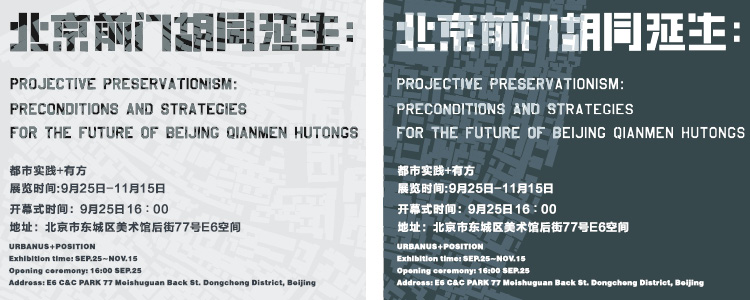Reservation: 010-57538123
URBANUS + POSITION
Projective Preservationism: Preconditions and Strategies for the Future of Beijing Qianmen Hutongs
Since 2014, URBANUS has been invited to join forces for the preservation, planning, research and design of Beijing’s Hutong and Siheyuan space in the Xianyukou, Qianmen Area. Meanwhile, POSITION has also been working to advance a comprehensive history and systematic analysis of current conditions of the same area. Although POSITION’s work differs from that of Urbanus in approach, the two organizations share a similar position on the obstacles and opportunities of Hutong preservation. As contemporary perception of the preservation, operation, and redevelopment of Hutongs becomes increasingly convergent from both top-down and left-right ideologies, the two organizations have decided to work in parallel in order to produce an exhibition containing a truly comprehensive analysis of existing conditions, broadening the platform for exploration and debate in order to more sensitively interrogate emerging issues.
Although history has rejected the practice of tabula-rasa demolition in traditional districts, current development practices performed under the guise of “preservation” continue to pursue construction in the absence of traditional Chinese culture. Against this prevailing modus operandi, the preservation of the Hutong courtyard fabric, improvement of extant infrastructures, and strategic injection of new elements are not only means to halt the spread of disorderedly construction within the traditional city fabric, but also a means of providing a revitalizing urban vitality within these districts. This research serves not only to enhance existing academic discourse on the subject, but to also provide an avenue for reclaiming historic preservation by advancing a collection of strategies and action-plans, projecting the preconditions of the continued growth of the Beijing Hutongs
Although tabula-rasa demolition in hutong area has been a history, current development practices performed under the guise of “preservation” continue to pursue construction destroying the real hutong texture. Against these prevailing methods, measures of preserving Hutong courtyard fabric, improving infrastructures, and injecting new elements are not only a means to halt the metastasization of disorderedly construction in this area, but also a way to provide a revitalizing urban vitality within these districts. This research serves not only to enhance existing academic discourse on the subject, but to provide strategies and action-plans for practical preservation, and to lay preconditions on the continued growth of Beijing Hutongs.
By displaying this research through both gallery-installation and video-presentation, this exhibition presents a comprehensive summary of the organizations’ work over the past two-years. In summary, this collaborative exhibition aims to unearth the essential features of the Hutong courtyard space in the east Qianmen area, ultimately providing strategic advice for the revitalization and preservation of this tragically vanishing district of old Beijing.

